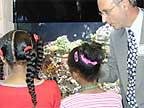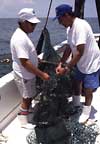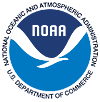Science serving America's coasts
The University Sea Grant Programs
The Sea Grant Act signed into law by President Bush on November 2002 states simply that the national interest requires a strategy to provide for the understanding and wise use of ocean, coastal and Great Lakes resources. Furthermore, the Act stipulates that the most suitable locus to promote such understanding is through NOAA's National Sea Grant College Program, and that the most cost effective way is through increased Federal support of Sea Grant activities.
Established in 1966 on the Land Grant concept, the National Sea Grant College Program today consists of 30+ university-based "centers of excellence" located throughout our nation's coastal and Great Lakes states. Each local center conducts integrated programs of research, education and outreach. Sea Grant is national in scope and yet locally implemented, involving over 3,000 scientists, engineers, outreach experts, educators and students drawn from over 300 institutions. Sea Grant's investments are focused on such high priority issues as aquaculture, marine biotechnology, coastal communities and economies, coastal hazards mitigation, understanding of ecosystems and habitats, fisheries and seafood technology, the urban coast, ocean technology, and education.
Sea Grant's University Infrastructure – The Key to Success
Sea Grant operates on a model of local, university-based programs. This paradigm has proven effective in engaging the academic enterprise in practical, critical research and outreach activities important to societal needs. By virtue of its extensive geographic coverage and diverse assets, Sea Grant can, through its infrastructure, address a more comprehensive, distributed array of issues that threaten the environmental security of America's coasts than is possible under a simple centrally managed program. Local management enables Sea Grant to effectively and economically direct resources to priority local and regional problems through integrated long term programs of research, outreach and local capacity building. Today the Sea Grant network involves this country's premier research universities nationwide. By building long-term relationships with numerous stakeholders, Sea Grant's university network is able to transfer objective science-based information to policy makers at all levels quickly and effectively. Today Sea Grant's "core" programs have more than 30 years of demonstrated accomplishment and represent a unique asset in the country's capability to address coastal environmental issues.
Program Core Elements
Research – Sea Grant research is competitive, peer reviewed science directed toward management of critical, geographically specific issues. Encouraging university expertise has resulted in advancements in marine resource management, new businesses and technologies, and greater understanding of the coastal environment. Examples range from improved sensors for environmental monitoring and promising drugs and industrial materials from the sea, to new uses for seafood by-products and better understanding of the economics and ecology behind contemporary fisheries management practices.
Outreach – Sea Grant extension programs provide informal education and technology transfer to users through a network of 300 extension agents and specialists. For example, Sea Grant is helping educate coastal community decision-makers about the impacts of land use on water quality, assisting growers to develop environmentally sound aquaculture, providing technical and planning assistance to communities to mitigate losses from natural hazards, and improve tourism opportunities. Local communications programs allow Sea Grant to deliver accurate, reliable, science-based information to target audiences. Two recent examples include books on port security for the United States and a new edition of a widely used safety manual for training fisherman.
Education – Sea Grant has a long tradition of increasing environmental literacy and building capacity through education. Sea Grant works with K-12 teachers to bring the environmental sciences into the classroom, trains undergraduate and graduate students (12,000 over three decades) in a broad range of disciplines, and offers fellowships for graduate students to gain science and policy experience with NOAA, the Congress, state and Federal agencies, and ocean industries.
Future Directions: Building on Sea Grant's Infrastructure and Leadership
Our national coastal, Great Lakes and ocean resources encompass an immense area including more than 95,000 miles of coastline and over 50 percent of our population. Coastal population is expected to increase by another 23 percent by 2015. The complexity of managing the natural and economic resources of the nation's coastal areas is immense and increasing as more pervasive environmental issues emerge. These issues can only be addressed well if we conduct good, relevant research and use effective means to get science-based information to decision makers and the public.
Sea Grant's network infrastructure represents one of the nation's most effective mechanisms for transferring objective, science-based information and technology on the sustainable use of marine resources, protection of coastal environments and economic development of the coastal zone.
Completing the Sea Grant Network - The addition of new Sea Grant programs in geographic areas not currently served, including several eligible states, as envisioned in the authorizing legislation.
Enhancing Sea Grant Science – Sound science is essential to informed public policy. Sea Grant research is currently greatly oversubscribed with only a small fraction (~20 percent) of proposals funded. This has a detrimental effect on critical areas of science and limits our ability to move in new directions. Increasing the number, average grant size, and duration of research projects would enable Sea Grant to greatly enhance the benefits of its research portfolio. Funding in support of the traditional link between conducting research and educating the next generation of scientists is also critical.
Extending the Reach of Outreach – Sea Grant's extension network is uniquely positioned to deliver science-based information to coastal constituents. A recent national review of the Extension Program indicated that Sea Grant fully funds fewer than seven extension personnel per program and concluded that level "is insufficient to address adequately the issues raised along the extensive reach of the nation's coastlines." For example, there are many geographic areas with only minimal coverage. As problems grow more complex, specialists are needed in many disciplines, such as coastal community development, urban environmental quality, fisheries and seafood technology, ports and harbors, and many other areas. Many constituencies simply cannot be served.
Education Leadership – Sea Grant plays a leadership role in science education and promotion of environmental literacy. Opportunities to expand partnerships with other Federal agencies (such as NSF's Centers of Ocean Science Education Excellence) abound. Enhanced teacher training, access to curriculum materials and successful fellowship programs represent highly beneficial products from Sea Grant's infrastructure that could be expanded to reach more educators and students.
Augmenting Regional Programs – It is clear that many contemporary problems in coastal resource management involve multi-state or regional issues. A recent National Research Council study pointed to a critical need for regional research planning and Federal coordination at that level. Sea Grant has a regional infrastructure well positioned to take a leadership role in cooperative regional efforts.
Budget and Staff
The fiscal year 2006 enacted budget for the Sea
Grant budget lines totaled $54.7M. The fiscal year 2007 President's
budget request for Sea Grant is $54.8M. The National Sea Grant Office currently
has 23 permanent Federal employees.




